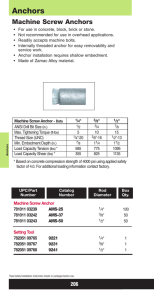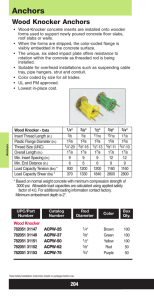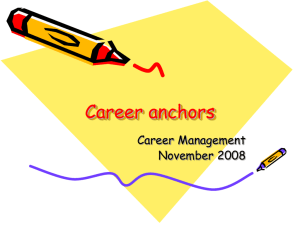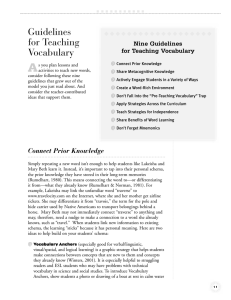ESR-2907 - Nelson Stud Welding Inc. - ICC-ES
advertisement
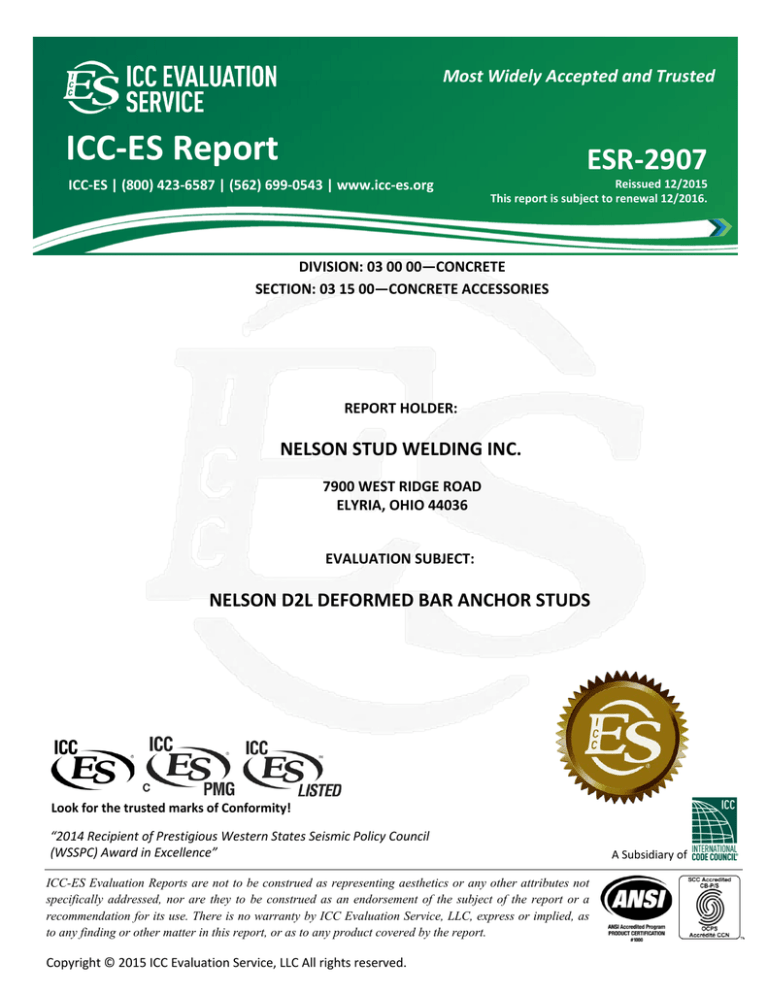
Most Widely Accepted and Trusted 0 ICC-ES Report ICC-ES | (800) 423-6587 | (562) 699-0543 | www.icc-es.org 000 ESR-2907 Reissued 12/2015 This report is subject to renewal 12/2016. DIVISION: 03 00 00—CONCRETE SECTION: 03 15 00—CONCRETE ACCESSORIES REPORT HOLDER: NELSON STUD WELDING INC. 7900 WEST RIDGE ROAD ELYRIA, OHIO 44036 EVALUATION SUBJECT: NELSON D2L DEFORMED BAR ANCHOR STUDS Look for the trusted marks of Conformity! “2014 Recipient of Prestigious Western States Seismic Policy Council (WSSPC) Award in Excellence” ICC-ES Evaluation Reports are not to be construed as representing aesthetics or any other attributes not specifically addressed, nor are they to be construed as an endorsement of the subject of the report or a recommendation for its use. There is no warranty by ICC Evaluation Service, LLC, express or implied, as to any finding or other matter in this report, or as to any product covered by the report. Copyright © 2015 ICC Evaluation Service, LLC All rights reserved. A Subsidiary of ICC-ES Evaluation Report ESR-2907 Reissued December 2015 This report is subject to renewal December 2016. www.icc-es.org | (800) 423-6587 | (562) 699-0543 DIVISION: 03 00 00—CONCRETE Section: 03 15 00—Concrete Accessories REPORT HOLDER: NELSON STUD WELDING, INC. 7900 WEST RIDGE ROAD ELYRIA, OHIO 44036 EVALUATION SUBJECT: NELSON D2L DEFORMED BAR ANCHOR STUDS 1.0 EVALUATION SCOPE Compliance with the following codes: A Subsidiary of the International Code Council ® AWS D1.1, such as ASTM A 36. Length and width depends on specification requirements. The minimum plate thickness must be 0.5 times the stud diameter. The use of base plate material of lesser thicknesses must be application-qualified according to Section 7.6 of AWS D1.1, to determine application acceptability. 4.0 DESIGN AND INSTALLATION 4.1 Allowable Loads: Allowable loads are shown in Tables 3 and 4. For single or grouped deformed bar anchors subject to combined tension and shear loading, that meet tension development length criteria in Table 1 and installation dimensions in Table 2, the following interactive equation applies: Ps Vs 1 Pt Vt 2009 International Building Code® (2009 IBC) 2006 International Building Code® (2006 IBC) Property evaluated: where: Structural 2.0 USES The deformed bar anchor studs are used to resist static tension and shear loads in uncracked normal-weight concrete. The anchors are alternatives to cast-in-place anchors described in Section 1911 of the IBC. 3.0 DESCRIPTION 3.1 General: The Nelson D2L Deformed Bar Anchor Studs are 3 1 deformed steel wire. Diameters include /8 inch, /2 inch, 5 3 /8 inch and /4 inch (9.5, 12.7, 15.9 and 19.1 mm). Nelson anchors may be used for concrete connections such as shear keys, bearing plates, column-base plates, beam-tocolumn connections, panel connections, angles, and column-to-column connections. The use of these anchors is limited to installation in uncracked normal-weight concrete. Ps = Applied tension load. Pt = Table 3 allowable tension load. Vs = Applied shear load. Vt = Table 4 allowable shear load. 4.2 Installation: The anchors must be welded to the plates according to Chapter 7 of AWS D1.1, using a stud welding gun. Typical installation requirements are indicated in Tables 1 through 4. The anchor must be placed in position before the concrete is cast, to fully embed these anchors. Surface conditions must comply with Section 7.4 of ACI 318. 4.3 Special Inspection: Special inspection during installation is required in accordance with Sections 1704.3 and 1704.4 of the IBC. Inspectors’ responsibilities include verifying: 1. Identification of anchors. 3.2 Material: 2. Concrete mix design. 3.2.1 Deformed Bar Anchors: The anchors are produced from deformed wire complying with ASTM A 496 and requirements for type C studs in accordance with the American Welding Society D1.1-2004 (AWS D1.1). The minimum yield strength is 70,000 psi (485 MPa) and the minimum tensile strength is 80,000 psi (550 MPa). 3. Quality of concrete. 4. Anchor tying and bracing. 5. Anchor clearances adjacent anchors. 6. Anchor size. 7. Concrete placement. 8. Concrete testing. 3.2.2 Steel Plate: Steel embedment plate material for stud welding must comply with one of the prequalified Group 1 or Group 2 base metals specified in Table 3.1 of between edges, base and ICC-ES Evaluation Reports are not to be construed as representing aesthetics or any other attributes not specifically addressed, nor are they to be construed as an endorsement of the subject of the report or a recommendation for its use. There is no warranty by ICC Evaluation Service, LLC, express or implied, as to any finding or other matter in this report, or as to any product covered by the report. 1000 Copyright © 2015 ICC Evaluation Service, LLC. All rights reserved. Page 1 of 3 ESR-2907 | Most Widely Accepted and Trusted 9. Sampling materials. 10. Welder qualifications. 11. Weld joint preparation. 12. Weld procedure and process. 13. Tolerances. 5.0 CONDITIONS OF USE Page 2 of 3 5.5 Anchors are limited to nonfire-resistive construction. 5.6 Special inspection is provided in accordance with Section 4.3. 5.7 When used in exterior moist locations, the deformed bar anchors must be shown to comply with IBC Section 1907.7.6 to the satisfaction of the code official. The Nelson D2L Deformed Bar Anchor Studs described in this report comply with, or are suitable alternatives to what is specified in, those codes listed in Section 1.0 of this report, subject to the following conditions: 5.8 When using the basic load combinations in accordance with IBC Section 1605.3.1.1, allowable tension and shear loads shown in Table 1 of this report are not permitted to be increased for wind loading. 5.1 Anchors are produced and installed in accordance with this report and the manufacturer’s instructions. In case of conflict between this report and the installation instructions, this report governs. Allowable loads are as set forth in this report. 5.9 When using the alternative basic load combinations in accordance with IBC Section 1605.3.2, that include wind loads, allowable tension and shear loads shown in Table 1 of this report are not permitted to be increased. 5.2 Calculations justifying that the applied loads comply with this report are submitted to the code official for approval. The calculations and details must be prepared by a registered design professional when required by the statutes of the jurisdiction in which the project is to be constructed. 5.10 Use of the anchors to resist seismic loads is beyond the scope of this report. 5.3 The use of the anchors subjected to fatigue, shock, or vibratory loads, such as those generated by reciprocating engines and crane loads, and moving loads due to vehicles, is outside the scope of this report. 5.4 The anchors are limited to installation in uncracked concrete. The use of the anchors in cracked concrete applications is outside the scope of this report. Cracking occurs when ft > fr due to service loads or deformations. 6.0 EVIDENCE SUBMITTED 6.1 Reports of tests in accordance with ASTM E 488. 6.2 Data in accordance with AWS D1.1-2004 and ASTM A 496. 6.3 A quality control manual. 7.0 IDENTIFICATION Nelson D2L Deformed Bar Anchor Studs are shipped in containers bearing the Nelson name, deformed bar diameter and length, the evaluation report number (ESR-2907), heat number, part number, lot number and number of pieces enclosed. In addition, the manufacturer’s symbol “N” is marked along the length of each deformed bar anchor for identification. ESR-2907 | Most Widely Accepted and Trusted Page 3 of 3 TABLE 1—TENSION DEVELOPMENT LENGTH FOR NELSON DEFORMED BAR ANCHOR STUDS MINIMUM EMBEDMENT LENGTH FOR FULL ANCHOR CAPACITY DEVELOPMENT, AFTER WELDING (inch) NORMAL-WEIGHT CONCRETE COMPRESSIVE STRENGTH, fNc (psi) Bar Diameter, db (inches) 3 1 /8 inch 5 /2 inch 3 /8 inch /4 inch 2,500 16 22 27 33 3,000 15 20 25 30 3,500 14 18 23 28 4,000 13 17 22 26 For SI: 1 psi = 6.894 kPa, 1 inch = 25.4 mm. 1 TABLE 2—INSTALLATION PARAMETERS PARAMETER TENSION LOADS Critical edge distance 10db Critical spacing Minimum cover at anchor base SHEAR LOADS 1 15db 1 7.5db 1 20db Section 1907.7.1 of the code Section 1907.7.1 of the code 1 1 db = bar diameter. TABLE 3—ALLOWABLE TENSION CAPACITY FOR NELSON D2L DEFORMED BAR ANCHORS WITH MINIMUM DEVELOPMENT LENGTHS AS SHOWN IN TABLE 1 ALLOWABLE TENSION CAPACITY(lbs) 2 BAR DIAMETER (inch) STRESS AREA, A1 (inch ) Based on Steel Yield Strength Based on Steel Ultimate Strength 3 0.11 1,925 2,200 1 0.19 3,325 3,800 5 0.29 5,075 5,800 0.41 7,175 8,200 /8 /2 /8 3 /4 2 2 For SI: 1 inch = 25.4 mm, 1 inch = 645.16 mm , 1 lbf = 4.44822 N. TABLE 4—ALLOWABLE SHEAR CAPACITY FOR NELSON DEFORMED BAR ANCHOR STUDS WITH 15db MINIMUM EMBEDMENT LENGTH FOR CONCRETE 1 WITH SPECIAL INSPECTION IN ACCORDANCE WITH THE IBC NOMINAL BAR DIAMETER (inch) ALLOWABLE SHEAR CAPACITY—NORMAL-WEIGHT CONCRETE 2 Area (inch ) 2,500 psi 3,000 psi 3,500 psi 4,000 psi 0.11 1,400 1,600 1,700 1,800 0.19 - 2,900 3,100 3,200 5 0.29 - 4,300 4,500 4,700 3 0.41 - 5,300 5,900 6,500 3 1 /8 /2 /8 /4 2 2 For SI: 1 inch = 25.4 mm, 1 inch = 645.16 mm , 1 psi = 6.894 kPa. 1 db = bar diameter
